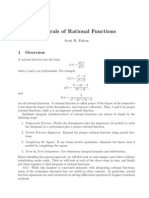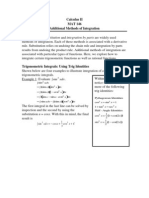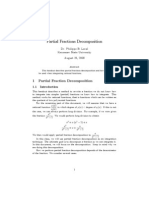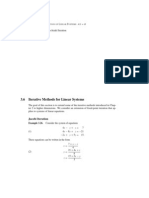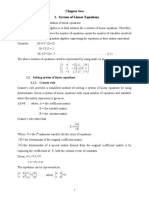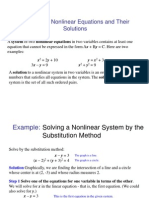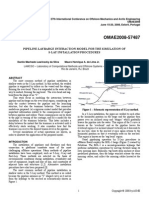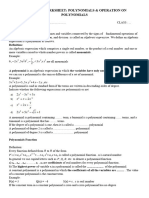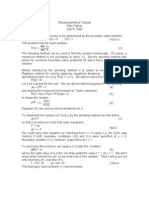X G (X) Techniques Used in The First Chapter To Solve Nonlinear Equations. Initially, We Will Apply
Uploaded by
donovan87X G (X) Techniques Used in The First Chapter To Solve Nonlinear Equations. Initially, We Will Apply
Uploaded by
donovan871
SOLVING SIMULTANEOUS EQUATIONS BY MATRIX ITERATION
In the previous chapter we studied direct matrix methods. Such methods employ a series of
algebraic operations (row transformations, row multiplications) that lead more or less directly to
an exact solution to the system of equations.
In this chapter we will examine iterative matrix methods. Such methods are based on starting with
initial guesses for the x values, and performing a sequence of algebraic operations to improve the
values. After many repetitions (iterations) of the algebraic operations the solution hopefully
converges to correct values for x. As will be seen, iterative approaches to the solution of a system
of equations are consistent with the
x = g(x) techniques used in the first chapter to solve nonlinear equations. Initially, we will apply
the iterative approach to systems of linear equations; however, we will see how they can also be
applied to systems of nonlinear equations.
A SIMPLE EXAMPLE
Consider the system of three equations in three unknowns:
'
+ +
+
+ +
2 3
3
6 2
3 2 1
3 2 1
3 2 1
x x x
x x x
x x x
We can solve the first equation for x
1
in terms of x
2
and x
3
; we can solve the second equation for
x
2
in terms of x
1
and x
3
; and we can solve the third equation for x
3
in terms of x
1
and x
2
:
'
+
+
3
2
2 3
1
1 3
1
3
3 1 2
2
6
3 2
1
2 2
1
1
3
x x x
x x x
x x x
Now we can guess initial values, say x
1
= 0, x
2
= 0, and x
3
= 0. Putting the guesses for x
2
and x
3
into the right hand side of the first equation leads to a new value of x
1
= 3. Putting the guesses for
x
1
and x
3
into the second equation leads to a new value of x
2
= -3. Finally, putting the guesses for
x
1
and x
2
into the third equation leads to a new value of x
3
= -2/3.
This process can be repeated for several iterations to arrive at x
1
= 8.5, x
2
= -11.25, and
x
3
= 0.25:
ITERATION
x
1
x
2
x
3
0 0 0 0
1 3.000 -3.000 -0.667
2 4.833 -6.667 -0.677
3 6.667 -8.500 -0.056
4 7.278 -9.722 -0.056
5 7.889 -10.333 0.148
30 8.500 -11.250 0.250
2
The connection with the x = g(x) method bears some examination. The first equation written
above is an x
1
= g
1
(x
1
, x
2
, x
3
) equation in the sense that an x
1
term is kept on the left hand side, and
all other terms are pulled to the right hand side. Because the equation is linear in x
1
, there were no
terms involving x
1
pulled to the right hand side in forming g
1
(x). Had the first equation been
nonlinear in x
1
, then x
1
would have appeared on both sides. Similar arguments can be made for
the other two equations.
ITERATIVE MATRIX TECHNIQUES THE JACOBI METHOD
A system of linear equations can be written in the form
[A]{x} = {b}
For the three equations that we have been considering,
[ ] { } { }
'
1
1
1
]
1
1
1
1
]
1
3
2
1
2
3
6
b
3 1 1
1 1 1
1 1 2
A
x
x
x
x
Now [A] can be decomposed (broken up) into two components:
[A] = [L + U] + [D]
where
[ ] [ ]
1
1
1
]
1
1
1
1
]
1
+
3 0 0
0 1 0
0 0 2
0 1 1
1 0 1
1 1 0
U L D
[L + U] contains a combination of the upper and lower off-diagonal terms, and [D] contains the
diagonal terms. The process of separating the [A] matrix into two components is called LU
decomposition.
After LU decomposition, the original system of equations can be written
[A]{x} [L + U]{x} + [D]{x} = {b}
Or, rearranging terms
[D]{x} = -[L + U]{x} + {b}
Notice that this equation is very close to being in an x = g(x) form. Specifically, because [D] is a
diagonal matrix, each x value is represented once and only once on the left hand side of the
system of equations. Moreover, [L + U] and {b} drag everything else to the right hand side.
3
For our system of equations this becomes
'
'
1
1
1
]
1
'
1
1
1
]
1
2
3
6
0 1 11
1 0 1
1 1 0
3 0 0
0 1 0
0 0 2
3
2
1
3
2
1
x
x
x
x
x
x
If the [D] matrix were just the identity matrix, [I], then we would have an x = g(x) setup.
Because [D][D
-1
] [I], we can arrange for the left hand side to be multiplied by the identity
matrix if we multiply the entire system through by [D
-1
]:
[D
-1
]{D]{x} = -[D
-1
][L + U]{x} + [D
-1
]{b}
or
{x} = -[D
-1
][L + U]{x} + [D
-1
]{b}
Furthermore, [D
-1
] is easy to obtain because, for any diagonal matrix, the inverse matrix is just a
diagonal matrix made up of the inverse of each diagonal term:
1
1
1
]
1
1
1
1
]
1
33
22
11
1
1
1
33
22
11
0 0
0 0
0 0 1
0 0
0 0
0 0
a
a
a
a
a
a
or, for our system of equations
1
1
1
]
1
1
1
1
]
1
3
1
2
1
0 0
0 1 0
0 0
3 0 0
0 1 0
0 0 2 1
We can simplify our notation by defining two new matrices:
[B] -[D
-1
][L + U] and {b} [D
-1
]{b}
For our system of equations
[ ]
1
1
1
]
1
1
1
1
]
1
1
1
1
]
1
0
1 0 1
0
0 1 1
1 0 1
1 1 0
0 0
0 1 0
0 0
3
1
3
1
2
1
2
1
3
1
2
1
B
4
{ }
'
'
1
1
1
]
1
3
2
3
1
2
1
'
3
3
2
3
6
0 0
0 1 0
0 0
b
The final x = g(x) equation becomes
{x} = [B]{x} + {b}
The iterative procedure would be performed by guessing values of x = x
n
to use on the right hand
side and computing new values of x = x
n+1
by solving the above equation. Thus
{x
n+1
} = [B]{x
n
} + {b}
For the first iteration for our system of equation we use guess values for x
n
and get:
{ }
'
'
'
1
1
1
]
1
+
3
2
3
2
3
1
3
1
2
1
2
1
1
3
3
3
3
0
0
0
0
1 0 1
0
n
x
which is what we got when we implemented this process by hand at the beginning of the chapter.
Repeated iteration leads to a series of values for the xs which can be seen to agree with the
values that we obtained in the hand process as shown in the table above.
You might also like
- Calculus II MAT 146 Additional Methods of Integration: Sin Sinx Sin Sinx 1 Cos Sinx Sinx Cos Sinxdx Sinx CosNo ratings yetCalculus II MAT 146 Additional Methods of Integration: Sin Sinx Sin Sinx 1 Cos Sinx Sinx Cos Sinxdx Sinx Cos7 pages
- 1 Determinants and The Solvability of Linear SystemsNo ratings yet1 Determinants and The Solvability of Linear Systems5 pages
- University of Zakho Faculty of Education Department of Mathematics Second Stage Semester 4No ratings yetUniversity of Zakho Faculty of Education Department of Mathematics Second Stage Semester 428 pages
- Gaussian Elimination and Its Tri-Diagonal VersionNo ratings yetGaussian Elimination and Its Tri-Diagonal Version20 pages
- 6.3 Exponential Equations and Inequalities: X 7 X 7 X 7 X 7 XNo ratings yet6.3 Exponential Equations and Inequalities: X 7 X 7 X 7 X 7 X11 pages
- A New Iterative Refinement of The Solution of Ill-Conditioned Linear System of EquationsNo ratings yetA New Iterative Refinement of The Solution of Ill-Conditioned Linear System of Equations10 pages
- Chapter 6: Integration: Partial Fractions and Improper IntegralsNo ratings yetChapter 6: Integration: Partial Fractions and Improper Integrals33 pages
- Solutions of Systems of Linear EqutionsNo ratings yetSolutions of Systems of Linear Equtions13 pages
- Kuttler LinearAlgebra AFirstCourse 2021A (020 040)No ratings yetKuttler LinearAlgebra AFirstCourse 2021A (020 040)21 pages
- [FREE PDF sample] (Ebook) Contemporary Linear Algebra, Student Solutions Manual by Howard Anton, Robert C. Busby ISBN 9780471170594, 0471170593 ebooks100% (3)[FREE PDF sample] (Ebook) Contemporary Linear Algebra, Student Solutions Manual by Howard Anton, Robert C. Busby ISBN 9780471170594, 0471170593 ebooks81 pages
- Bowman D, Choi G - G-Continued Fractions For Basic Hyper Geometric Functions II - J. Math. Anal. Appl. 284 (2003) 435-446No ratings yetBowman D, Choi G - G-Continued Fractions For Basic Hyper Geometric Functions II - J. Math. Anal. Appl. 284 (2003) 435-44612 pages
- ALGEBRA SIMPLIFIED EQUATIONS WORKBOOK WITH ANSWERS: Linear Equations, Quadratic Equations, Systems of EquationsFrom EverandALGEBRA SIMPLIFIED EQUATIONS WORKBOOK WITH ANSWERS: Linear Equations, Quadratic Equations, Systems of EquationsNo ratings yet
- A Brief Introduction to MATLAB: Taken From the Book "MATLAB for Beginners: A Gentle Approach"From EverandA Brief Introduction to MATLAB: Taken From the Book "MATLAB for Beginners: A Gentle Approach"2.5/5 (2)
- Student's Solutions Manual and Supplementary Materials for Econometric Analysis of Cross Section and Panel Data, second editionFrom EverandStudent's Solutions Manual and Supplementary Materials for Econometric Analysis of Cross Section and Panel Data, second editionNo ratings yet
- Mathematics 1St First Order Linear Differential Equations 2Nd Second Order Linear Differential Equations Laplace Fourier Bessel MathematicsFrom EverandMathematics 1St First Order Linear Differential Equations 2Nd Second Order Linear Differential Equations Laplace Fourier Bessel MathematicsNo ratings yet
- Student Solutions Manual to Accompany Economic Dynamics in Discrete Time, secondeditionFrom EverandStudent Solutions Manual to Accompany Economic Dynamics in Discrete Time, secondedition4.5/5 (2)
- Computer Simulations and Working Model 2D: Cosmos LectureNo ratings yetComputer Simulations and Working Model 2D: Cosmos Lecture14 pages
- 2.4 - Further Analysis of Polynomial Functions Math 30-1No ratings yet2.4 - Further Analysis of Polynomial Functions Math 30-112 pages
- Chap6 Duality Theory and Sensitivity Analysis: College of Management, NCTU Operation Research I Fall, 2008No ratings yetChap6 Duality Theory and Sensitivity Analysis: College of Management, NCTU Operation Research I Fall, 200826 pages
- Experiment No. 1 - Development of Algorithm Using MS Excel and MATLABNo ratings yetExperiment No. 1 - Development of Algorithm Using MS Excel and MATLAB19 pages
- OMAE2008-57487: Pipeline-Laybarge Interaction Model For The Simulation of S-Lay Installation ProceduresNo ratings yetOMAE2008-57487: Pipeline-Laybarge Interaction Model For The Simulation of S-Lay Installation Procedures10 pages
- Example: Travelling Salesman Problem: To From 1 2 3 4 5 1 2 3 4 5No ratings yetExample: Travelling Salesman Problem: To From 1 2 3 4 5 1 2 3 4 53 pages
- Stochastic Gradient Descent (SGD) :: Import AsNo ratings yetStochastic Gradient Descent (SGD) :: Import As4 pages
- A NURBS Enhanced Extended Finite Element Approach For Unfitted CAD AnalysisNo ratings yetA NURBS Enhanced Extended Finite Element Approach For Unfitted CAD Analysis17 pages
- Answer:: Chapter 19 - Solution Procedures For Transportation and Assignment Problems True / FalseNo ratings yetAnswer:: Chapter 19 - Solution Procedures For Transportation and Assignment Problems True / False13 pages
- Quadratic Equations and Sequence Series 2No ratings yetQuadratic Equations and Sequence Series 244 pages
- Fuzzy Goal Programming Complementary Sla PDFNo ratings yetFuzzy Goal Programming Complementary Sla PDF17 pages
- Multiple Regression and Correlation AnalysisNo ratings yetMultiple Regression and Correlation Analysis1 page
- Calculus II MAT 146 Additional Methods of Integration: Sin Sinx Sin Sinx 1 Cos Sinx Sinx Cos Sinxdx Sinx CosCalculus II MAT 146 Additional Methods of Integration: Sin Sinx Sin Sinx 1 Cos Sinx Sinx Cos Sinxdx Sinx Cos
- 1 Determinants and The Solvability of Linear Systems1 Determinants and The Solvability of Linear Systems
- University of Zakho Faculty of Education Department of Mathematics Second Stage Semester 4University of Zakho Faculty of Education Department of Mathematics Second Stage Semester 4
- 6.3 Exponential Equations and Inequalities: X 7 X 7 X 7 X 7 X6.3 Exponential Equations and Inequalities: X 7 X 7 X 7 X 7 X
- A New Iterative Refinement of The Solution of Ill-Conditioned Linear System of EquationsA New Iterative Refinement of The Solution of Ill-Conditioned Linear System of Equations
- Chapter 6: Integration: Partial Fractions and Improper IntegralsChapter 6: Integration: Partial Fractions and Improper Integrals
- Kuttler LinearAlgebra AFirstCourse 2021A (020 040)Kuttler LinearAlgebra AFirstCourse 2021A (020 040)
- [FREE PDF sample] (Ebook) Contemporary Linear Algebra, Student Solutions Manual by Howard Anton, Robert C. Busby ISBN 9780471170594, 0471170593 ebooks[FREE PDF sample] (Ebook) Contemporary Linear Algebra, Student Solutions Manual by Howard Anton, Robert C. Busby ISBN 9780471170594, 0471170593 ebooks
- Bowman D, Choi G - G-Continued Fractions For Basic Hyper Geometric Functions II - J. Math. Anal. Appl. 284 (2003) 435-446Bowman D, Choi G - G-Continued Fractions For Basic Hyper Geometric Functions II - J. Math. Anal. Appl. 284 (2003) 435-446
- ALGEBRA SIMPLIFIED EQUATIONS WORKBOOK WITH ANSWERS: Linear Equations, Quadratic Equations, Systems of EquationsFrom EverandALGEBRA SIMPLIFIED EQUATIONS WORKBOOK WITH ANSWERS: Linear Equations, Quadratic Equations, Systems of Equations
- A-level Maths Revision: Cheeky Revision ShortcutsFrom EverandA-level Maths Revision: Cheeky Revision Shortcuts
- A Brief Introduction to MATLAB: Taken From the Book "MATLAB for Beginners: A Gentle Approach"From EverandA Brief Introduction to MATLAB: Taken From the Book "MATLAB for Beginners: A Gentle Approach"
- Student's Solutions Manual and Supplementary Materials for Econometric Analysis of Cross Section and Panel Data, second editionFrom EverandStudent's Solutions Manual and Supplementary Materials for Econometric Analysis of Cross Section and Panel Data, second edition
- Mathematics 1St First Order Linear Differential Equations 2Nd Second Order Linear Differential Equations Laplace Fourier Bessel MathematicsFrom EverandMathematics 1St First Order Linear Differential Equations 2Nd Second Order Linear Differential Equations Laplace Fourier Bessel Mathematics
- Student Solutions Manual to Accompany Economic Dynamics in Discrete Time, secondeditionFrom EverandStudent Solutions Manual to Accompany Economic Dynamics in Discrete Time, secondedition
- Computer Simulations and Working Model 2D: Cosmos LectureComputer Simulations and Working Model 2D: Cosmos Lecture
- 2.4 - Further Analysis of Polynomial Functions Math 30-12.4 - Further Analysis of Polynomial Functions Math 30-1
- Chap6 Duality Theory and Sensitivity Analysis: College of Management, NCTU Operation Research I Fall, 2008Chap6 Duality Theory and Sensitivity Analysis: College of Management, NCTU Operation Research I Fall, 2008
- Experiment No. 1 - Development of Algorithm Using MS Excel and MATLABExperiment No. 1 - Development of Algorithm Using MS Excel and MATLAB
- OMAE2008-57487: Pipeline-Laybarge Interaction Model For The Simulation of S-Lay Installation ProceduresOMAE2008-57487: Pipeline-Laybarge Interaction Model For The Simulation of S-Lay Installation Procedures
- Example: Travelling Salesman Problem: To From 1 2 3 4 5 1 2 3 4 5Example: Travelling Salesman Problem: To From 1 2 3 4 5 1 2 3 4 5
- A NURBS Enhanced Extended Finite Element Approach For Unfitted CAD AnalysisA NURBS Enhanced Extended Finite Element Approach For Unfitted CAD Analysis
- Answer:: Chapter 19 - Solution Procedures For Transportation and Assignment Problems True / FalseAnswer:: Chapter 19 - Solution Procedures For Transportation and Assignment Problems True / False

